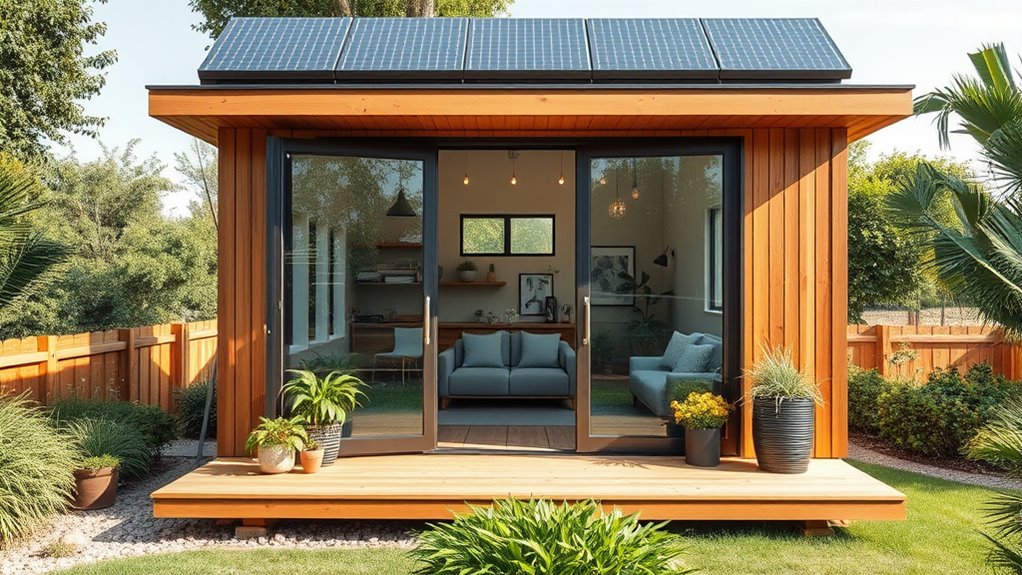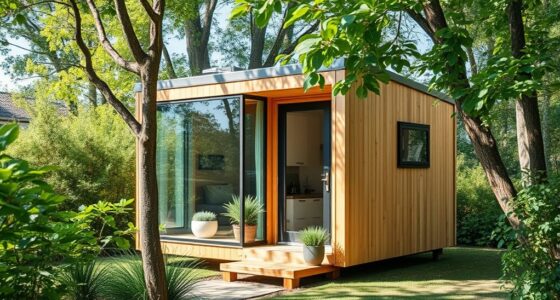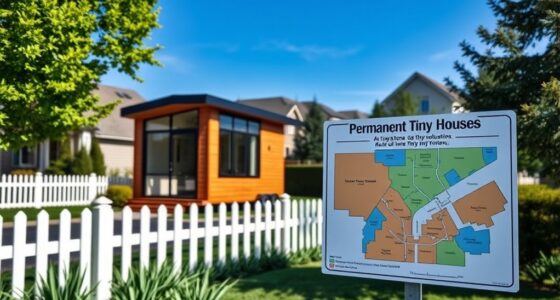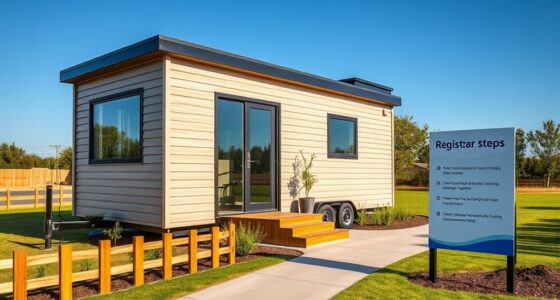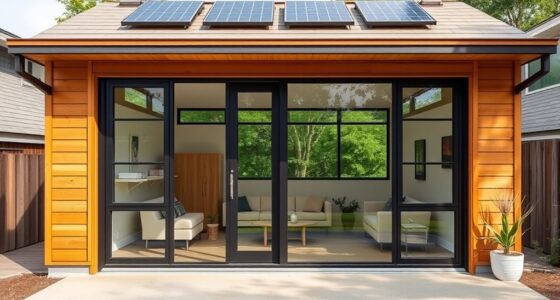To convert your tiny house into a legal, permanent residence, you’ll need to check local zoning laws and get any necessary permits or variances. You should also connect to utility services like water, sewer, and electricity, ensuring all work meets building codes through proper inspections. Planning for a suitable land spot and understanding community rules are essential steps. Continuing with the process will guide you through each critical detail for establishing a compliant and comfortable home.
Key Takeaways
- Verify local zoning laws to classify your tiny house as a permanent residence and obtain necessary permits.
- Connect to appropriate utilities, ensuring compliance with local building codes and inspection requirements.
- Secure a suitable piece of land that allows for long-term habitation and adheres to zoning restrictions.
- Work with licensed professionals for electrical, plumbing, and septic installations to ensure safety and code compliance.
- Maintain ongoing compliance with community regulations, permits, and safety standards for sustainable, legal living.

Turning a tiny house into a permanent residence is an achievable goal that requires careful planning and execution. The first step is to understand local zoning regulations, which can vary substantially depending on your area. Some jurisdictions may classify tiny houses as RVs, while others treat them as permanent dwellings. This classification impacts where you can place your tiny home and what building codes you’ll need to meet. Before making any modifications or settling on a location, check with your local zoning department to guarantee your tiny house complies with all rules. If zoning laws are restrictive, you might need to seek variances or special permits, which can take time but are essential for legal residence.
Understanding local zoning laws is crucial for turning a tiny house into a permanent residence.
Next, you’ll need to focus on utility hookups, a vital part of converting your tiny house into a permanent home. This involves connecting your home to essential services like water, sewer, electricity, and possibly gas. First, determine whether your tiny house will be stationary or on wheels; this affects the type of hookups you’ll need. For stationary homes, connecting to city water and sewer lines is ideal, but if you’re in a rural or less developed area, installing a septic system or well might be necessary. For electricity, you can either connect to the grid or opt for off-grid solutions such as solar panels and batteries. If you’re on a property with existing utility connections, coordinate with local providers to guarantee proper hookup procedures and inspections. If you’re in an area without existing infrastructure, you’ll need to plan for installing the necessary systems yourself or through professionals. Additionally, selecting a waterproof and durable planters for your outdoor space can enhance your tiny house’s curb appeal and promote sustainable gardening practices.
Making your tiny house a permanent residence also involves guaranteeing your utility hookups meet local building codes and safety standards. This might mean obtaining permits and passing inspections, especially for electrical and plumbing systems. You’ll want to work with licensed professionals to handle these installations, ensuring everything is up to code and safe for long-term living. Additionally, some areas require inspections before approving your utility connections, so be prepared for these steps in the process.
Finally, consider long-term planning for your tiny house’s permanent residence. This includes securing a suitable plot of land, navigating homeowners’ association rules if applicable, and planning for future maintenance and upgrades. Converting a tiny house into a permanent home is about more than just hooking up utilities and complying with zoning; it’s about creating a legal, safe, and comfortable living environment that fits within your community’s guidelines. By thoroughly understanding local regulations and carefully managing utility hookups, you’ll be well on your way to turning your tiny house into a true, permanent home.
Frequently Asked Questions
What Are the Zoning Restrictions for Tiny House Conversions?
You need to check local zoning laws and building codes before converting your tiny house into a permanent residence. Zoning restrictions can limit where you place your tiny home, such as setbacks, minimum lot size, or whether it’s allowed as a primary residence. Building codes ensure safety standards are met, covering insulation, electrical, and plumbing requirements. Always contact your local planning department to confirm restrictions and get necessary permits.
How Do I Secure Financing for a Permanent Tiny House?
To secure financing for your tiny house as a permanent residence, start by exploring tiny house financing options through specialized lenders or credit unions. You can also consider personal loans or RV loans if your tiny house qualifies. Make certain you have documentation showing your tiny house meets local building codes. Gathering proof of your plans for permanent residence funding will strengthen your application and increase your chances of approval.
What Permits Are Required for Permanent Installation?
Think of permits as the golden ticket to your tiny house dream. You’ll need building permits, zoning approvals, and sometimes environmental clearances, depending on your location. To guarantee your tiny house design aligns with local codes, prioritize sustainable materials that meet safety standards. Contact your city or county planning office early, so you can navigate the permitting maze smoothly, turning your tiny house into a permanent, legal haven.
How Do I Ensure Proper Insulation and Climate Control?
You need to choose the right insulation materials like spray foam, foam board, or mineral wool to guarantee your tiny house stays warm in winter and cool in summer. Install proper climate systems such as a mini-split heat pump, space heater, or portable A/C for efficient temperature control. Seal gaps and vents to prevent drafts, and regularly inspect your insulation and climate systems to maintain comfort and energy efficiency year-round.
Can I Connect a Tiny House to Existing Utilities?
Think of connecting your tiny house to existing utilities like plugging into a familiar power source. You can definitely hook up to utility hookups, but keep in mind that renovation costs vary depending on your setup. I once helped a friend connect her tiny home to water and electric lines, saving her money and hassle. Carefully plan your connections, consult local codes, and budget accordingly to make this process smooth and safe.
Conclusion
Now that you’ve transformed your tiny house into a permanent home, it’s funny how everything fell into place—each upgrade, each decision, aligning perfectly. It’s almost as if the journey was meant to be, guiding you toward this cozy, efficient space. With your new home ready to embrace every moment, you’ll find comfort in knowing that sometimes, life’s little coincidences lead to the most meaningful adventures. Your tiny house is now truly your forever home.
